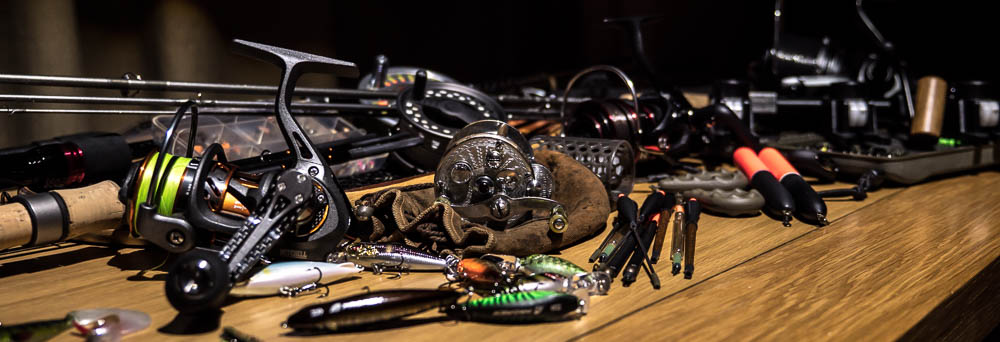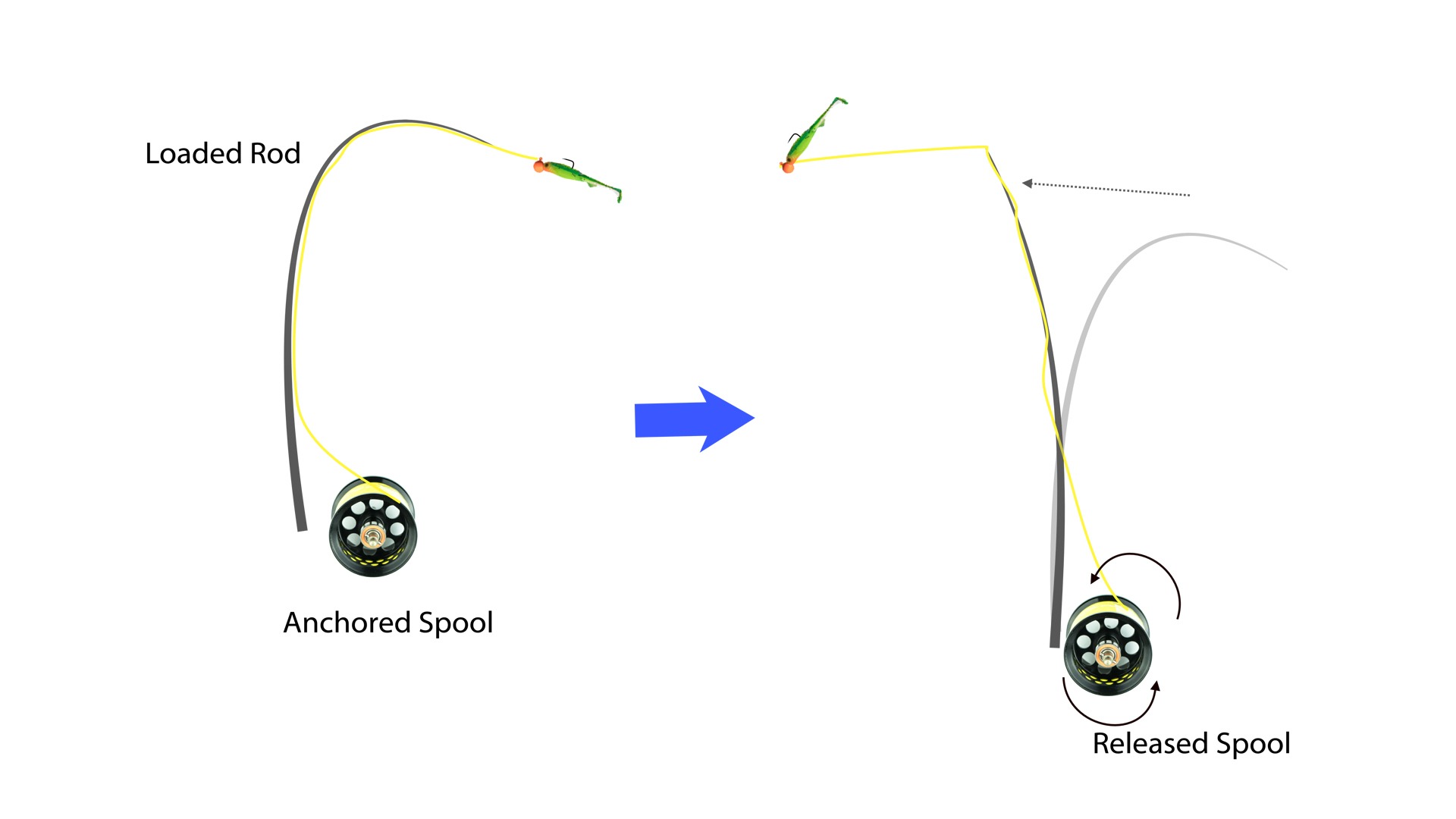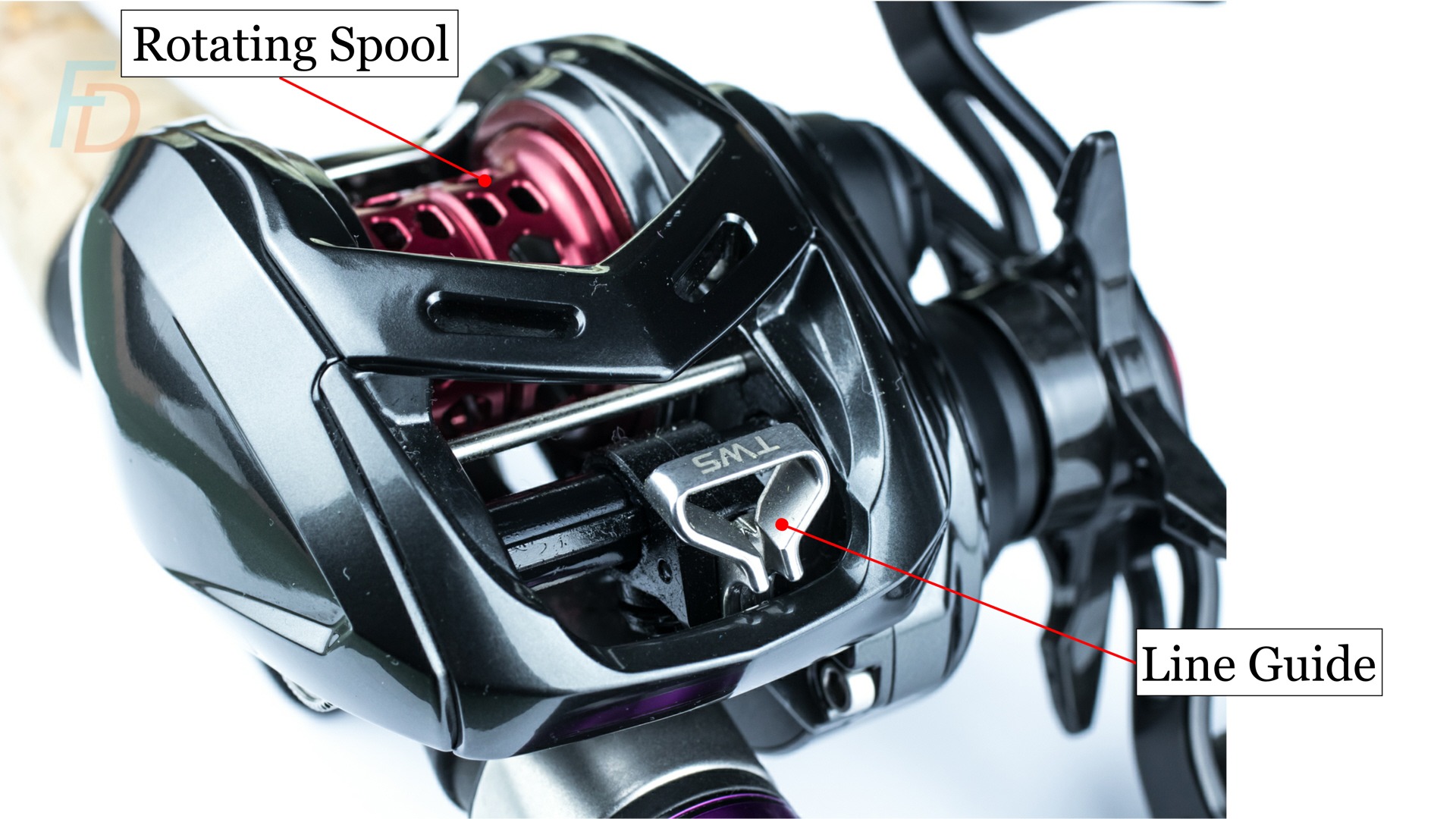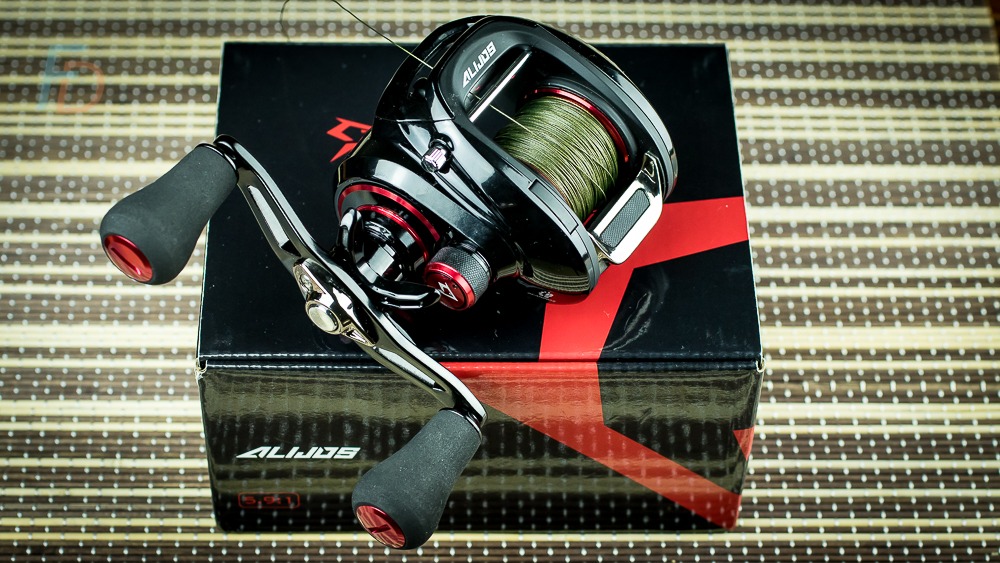Not sure whether a baitcaster or spinning reel is the best option? Here’s a breakdown that should help you out.

Baitcaster or Spinning Reel: Most Basic Comparison
Starting with the simplest comparison might be as far as you need to go on this – so let’s not overcomplicate your choice if we don’t need to. Looking at the basic characteristics of each reel type will help you make the best choice of baitcaster or spinning reel.
Spinning Reels
Whether or not you actually “spin” (lure fish with spinners) with these style reels is something we’ll look at below – but “spinning reels” are a kind of fixed spool reel. In other words, while all spinning reels are fixed spool reels – not all fixed spool reels are spinning reels. That being said, it is quite common for the names to be used interchangeably.
A fixed spool reel is one where the line is retrieved and wound onto the spool by an external rotating arm (called a bail arm):

So, while reeling in the spool is fixed in place – which is where the name comes from. The only time the spool rotates is when a fish pulls line against the drag – and this is one of the first major differences between baitcasting reels and spinning reels:
If you try to wind in while the drag is peeling out, the rotation of the spool combined with the wrapping action of the bail arm puts twists into your line.
Eventually this will lead to horrendous tangles in your line when you’re using a fixed spool spinning reel.
So why use a spinning reel?
First of all, as long as it’s properly loaded with line, a spinning reel is fantastic for casting very light weight lures, baits, floats. This is because whatever weight you are casting only needs to overcome the mass of the line being cast and the friction of the line peeling over the lip of the forward-facing spool.

Line peeling off the front lip of a fixed spool during the cast
With a baitcaster, whatever you’re casting needs to have enough momentum to overcome the inertia of the whole spool plus the full amount of line loaded on that spool:

Also, even if you get a cast really wrong and either send it straight up in the air or bomb it in right at your feet; the full spool of line won’t automatically tangle up on you. If you’re casting a lure, as soon as it stops, the line also stops...
That’s not true with a baitcaster – if the lure slows down or stops; the rotation of the spool will continue to spill line out and will cause terrible tangles unless braked by your thumb or a special braking system..
As long as you know the sequence of how to cast a fishing rod using either a baitcaster or spinning reel; then spinning reels are easier to use and less prone to tangling during the cast. On the other hand, winding against a fish while it is pulling drag on a spinning reel will eventually cause a tangle that you’ll have to cut off your reel.
Why use a baitcaster?
If you’re casting something weighing over, say ½ oz (15g), then it’s possible to cast enough line off the spool of a spinning reel to create a sharp angle and create a lot more friction for line leaving that spool (e.g. below). The thicker/stronger your line is the earlier in the cast this problem occurs and the worse the friction effect is:

Friction limitation of a fixed spool spinning reel when the spool is not completely filled
Once you start a baitcaster spool rotating during a cast – its momentum will make that spool want to keep rotating - whether or not the casting weight is pulling line off the spool. With heavier casting weights and longer casts this can be an advantage in creating long, smooth casts.
The mechanism of the spool being rotated by the gearing of the reel when cranking line back in can also mean that baitcasting reels are better for winding in against strong resistance. A shuttling “line-guide” helps to spread the coils of line evenly across the spool. For spinning reels the line-wrapping action of a bail-arm can be more erratic and less robust.

Control of the line as it is paying out during the cast is also much easier with a baitcaster (which, in turn, can make it a lot easier to change and control the flight of your cast).
With the one-hand action of pressing the thumb bar for casting; baitcasters can be more efficient for “power fishing” styles. In those methods (where many, many repeated casts and retrieves are made) the “line-trap then other hand flip bail-arm open then cast” sequence for a spinning reel is less efficient.
The take home message from a basic comparison would be: Spinning reels are generally easier to use and can be better for the lightest casting weights – but overcoming the speed-bump of using a baitcaster can give significant advantages in certain situations.
Let’s look a bit deeper at some specific fishing scenarios where you might need to make an informed choice between baitcaster or spinning reel.
Baitcaster or Spinning Reel: Medium to Heavy Lure fishing in Fresh Water
This situation can fall into the “power fishing” scenario we left off with in the basic comparison section. Another consideration which we’ll find in fishing heavier lures (as well as surf-casting) is the potential pain of line twanging out from under your “trigger finger” when using a spinning reel. When using a baitcaster, having your thumb on the spool to control the line-release makes throwing heavy baits on powerful rods much more comfortable.

Accuracy and control when bombing weighty lures up against cover can be easier with a baitcaster (due to that mid-flight thumb-control option).
For retrieving your baits and giving them the action you want, there tends to be a wider variety of gear ratios and line-retrieved per handle-turn ratings for baitcasting reels.
Verdict: If what you have are spinning reels and you can’t cast a baitcaster – then spinning reels will be fine for this style. BUT – if you’re able to use them, baitcasting reels take a clear "Win" on this round..
Finesse and Ultralight Lure Fishing
This is where it gets pretty interesting. Until recently if you wanted to cast a lure in the 1 to 2g (VERY ROUGHLY 1/32nd to 1/16th oz) range then your only option was a spinning reel.
Enter Bait Finesse System (BFS) from Japan…this is where the concept of ultralight baitcasting reels with special, shallow spools, micro-bearings and high-performance braking systems have been pushed to the max. Now it is perfectly possible to cast down to those kinds of lure weights with a baitcaster.
BUT – just because you can, does that mean you should??
This is a highly contentious subject. In all likelihood, you’ll always be able to cast a 1/32nd oz lure further with a spinning reel. That’s just something which I can’t see the laws of physics allowing to change.
On the other hand – you can be casting slightly heavier lures that are still very much in the ultralight, finesse category and those maximum distances become much more difficult to choose between...
Then again, is your ultralight lure fishing only about distance? If accuracy and the ability to drop the lure in as lightly as possible; then the BFS approach makes that easier to achieve. When casting a spinning reel, yes you can “feather” the line as it goes out and you can trap it with a finger against the spool to allow you some control as you put the lure down on the water.
There’s no getting away from the fact that both those operations are easier with a baitcaster though.
To counter that, even if you can cast with a regular baitcasting reel, you might need some additional practice and tuning up those casting skills to get good with a BFS reel. Here’s a guide to getting good at BFS casting in case it’s a path you’d like to go down.
One clear difference is in the avoidance of line twist when winding against the drag of a baitcasting reel – something that is both very likely and very damaging when using ultralight reel lines in the 1 to 6-lb breaking strain range for monofilament (nylon or fluorocarbon).
What About Choosing on Cost?
Time was (until very recently) when getting hold of BFS gear would cost you an arm and a leg via expensive (and brilliant) Japanese imports for reels and rods. Now there’s a bit of a revolution going on with a complete price range from incredibly affordable through mid-range right up to those luxury options. The rod and reel combo below cost me less than $80:

The cheapest, usable, spinning reels in finesse sizes (say around 1000 to 2000 size) will probably always be that little bit lower cost than the cheapest BFS reels. However, the gap is now so small as to make very little difference.
Baitcaster or Spinning Reel For UL Finesse: Final Reckoning?
This one is probably one of the most difficult choices to settle in favour of either baitcaster or spinning reel.
Verdict: Score Draw - Ultimately, the choice comes down to whether the ease and familiarity of using a spinning reel (and how often you fish around the 1/32nd oz lure range) make a BFS rig less practical for you.
From a personal satisfaction point of view, getting over an initial speed bump with casting can make the ultralight baitcasters of BFS a great choice for accuracy, lack of line twist and delicacy...
Both styles of reel offer great options in this type of fishing, and you may well end up owning reels belonging to each camp.
Baitcaster or Spinning Reel: Freshwater Bait Fishing (Including Carp)
For me this one is a bit more clear-cut. Unless you are launching huge dead-baits over the horizon (and even then…) the most suitable tool for bait fishing will tend to be a fixed spool/spinning reel.
At the ultra-delicate end of the spectrum, casting a light float (e.g. waggler fishing) into even a light breeze is likely to be a miserable experience while using a baitcaster.
For many styles of fishing bottom baits for specimen-sized fish, having a “baitrunner” facility (where the line can be paid out with the fish feeling little resistance – but without causing an over-run; e.g. below) is essential. That function, with a completely separate setting for the fish-fighting drag which is engaged by a turn of the handle is only found on fixed spool reels:

When it comes to float (bobber) fishing on rivers, allowing your rig to drift naturally down the current is relatively easy with a spinning/fixed-spool reel (though for this “trotting” style, people often choose centre-pin reels too; learn more about trotting here). The ability to open the bail arm to pay line out freely at the pace of the current – without your spool becoming a bird’s nest of tangled line is a big advantage.
Trying the same thing with a baitcaster is, again, not a recipe for fun. Putting a baitcaster into free-spool risks over-runs – with even the lightest thumb-pressure likely to cause a jerky downstream drift. A big part of that is the smaller diameter of a baitcaster’s spool compared to a trotting centrepin – which has much more momentum and is way easier to get a match between rotational speed and the pace of the current.
Baitcaster or Spinning Reel for Deep Ocean Fishing (Boat)?
This is another pretty clear-cut choice – as long as you can operate a baitcaster well enough to pay out line, engage the spool and crank the handle. This time, the usual winner (based on performance, practicality and enjoyment) will be the baitcaster.

As well as the previously-mentioned tendency for stronger cranking performance, baitcasters can also generally hold more line on a spool for a given size of reel (a spinning reel has to be pretty big to engineer a robust bail arm/wrapping mechanism that can cope with a giant spool without lots of line-tangling problems).
Surf Casting
To finish off with, this is another more difficult choice – with plenty of people having a preference for either of the baitcaster or spinning reel options.
While there will be an increasing amount of spool-lip-friction as the line flies out from a spinning reel (and generally relatively thick line being favoured will magnify this), it tends to be easier for an average angler to throw out a respectable cast.

The very high spool-rotational speeds associated with blasting out a long surf-cast using a baitcaster always carry the risk of the most spectacular blow-ups of line-coils you are likely to see anywhere. On the other hand, this style of casting often makes it necessary to employ some kind of mechanical solution the finger-ripping sensation of releasing line from a fixed spool reel…Whereas that is a bit easier to manage on a baitcaster.

The potential advantage over such long-range casts is that, with a rotating spool on a baitcaster, there should be less distance lost towards the end of a cast (where fixed spool reels experience more drag effect from the rapidly-emptying spool).
Verdict: Score Draw - – in fact, this choice is probably even closer than the split between BFS and UL spinning…
Perhaps the most common path is for people to start out surf casting with a fixed-spool spinning reel and then learning how to cast well with a baitcasting reel later.
Round-up
Right, that about covers the major situations I can think of. Overall, learning to cast with a baitcaster can open up some significant advantages in predator and lure fishing. Conversely, if you've only ever fished a baitcaster, there are multiple bait-fishing scenarios where learning to use a spinning reel properly will improve your prospects a great deal.
Let me know in the comments if you have any other suggestions for situations where you'd favour a baitcaster or spinning reel for a specific job.
Whichever reel style you choose - it is worth protecting the internal parts against grit and corrosion; as well as having it performing optimally. There's a guide to this in my breakdown of the best fishing reel lubrication products (as well as a money-saving/half price offer).
Paul

[…] Baitcaster or Spinning Reel? Getting the Right Reel for the Job […]